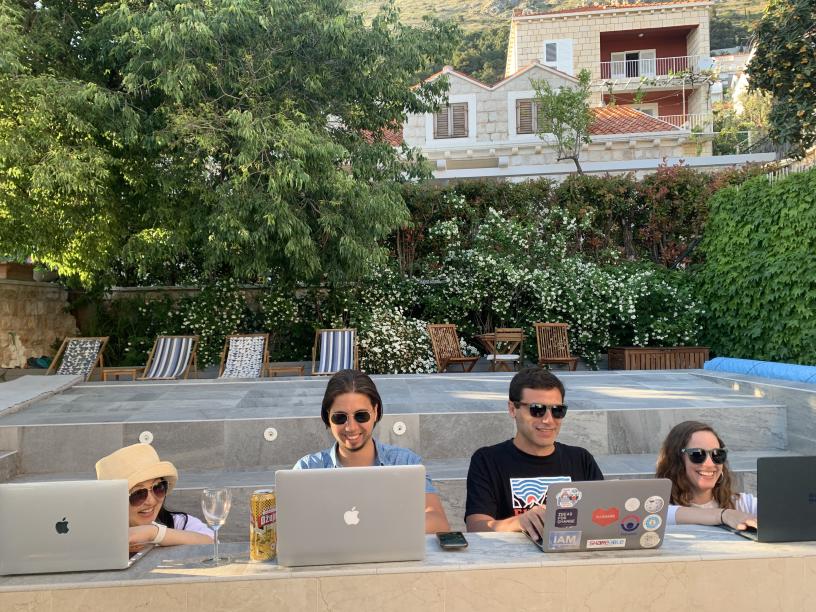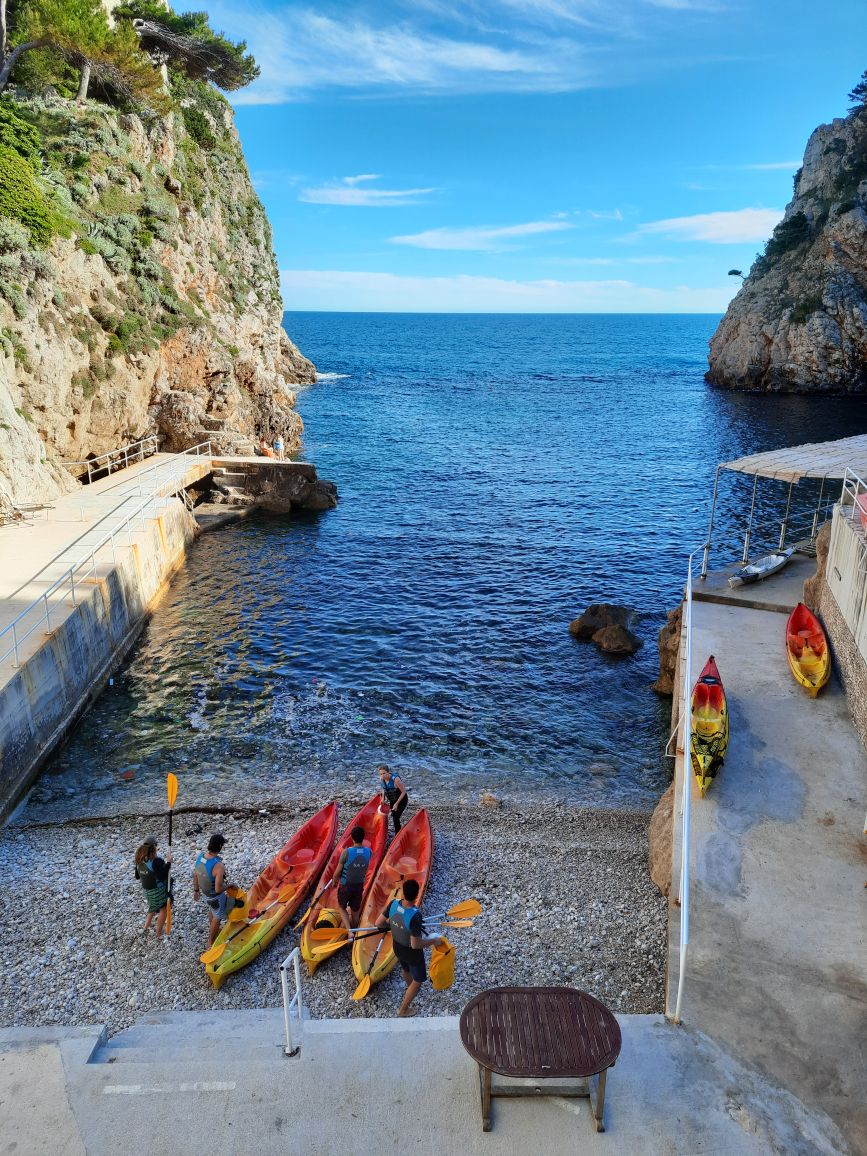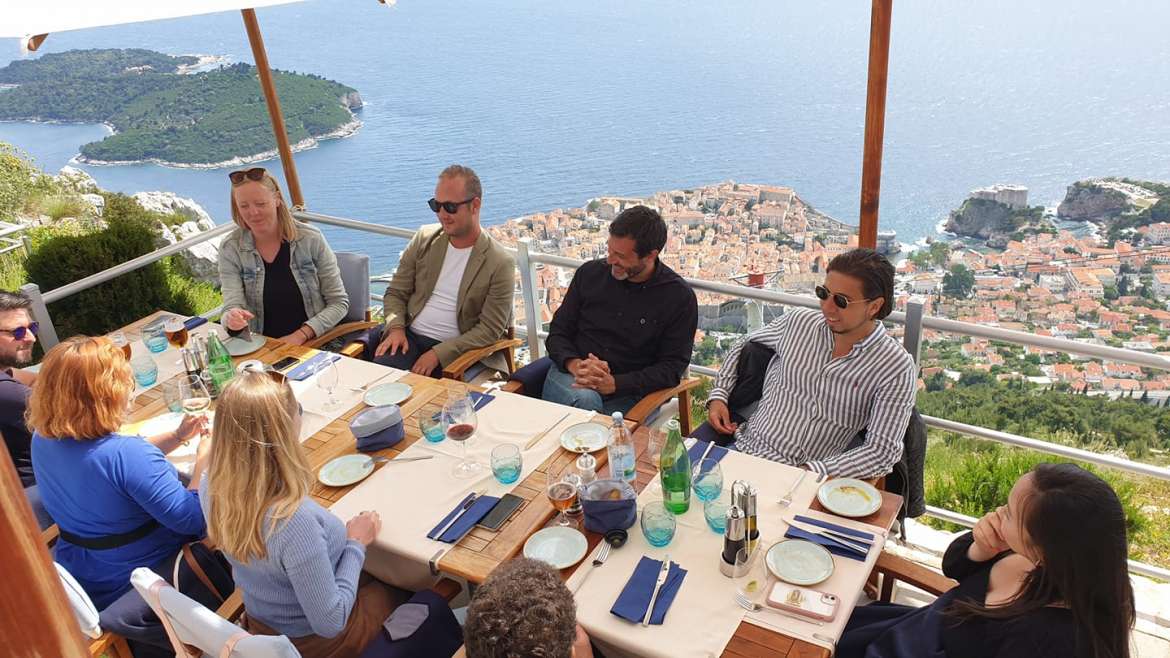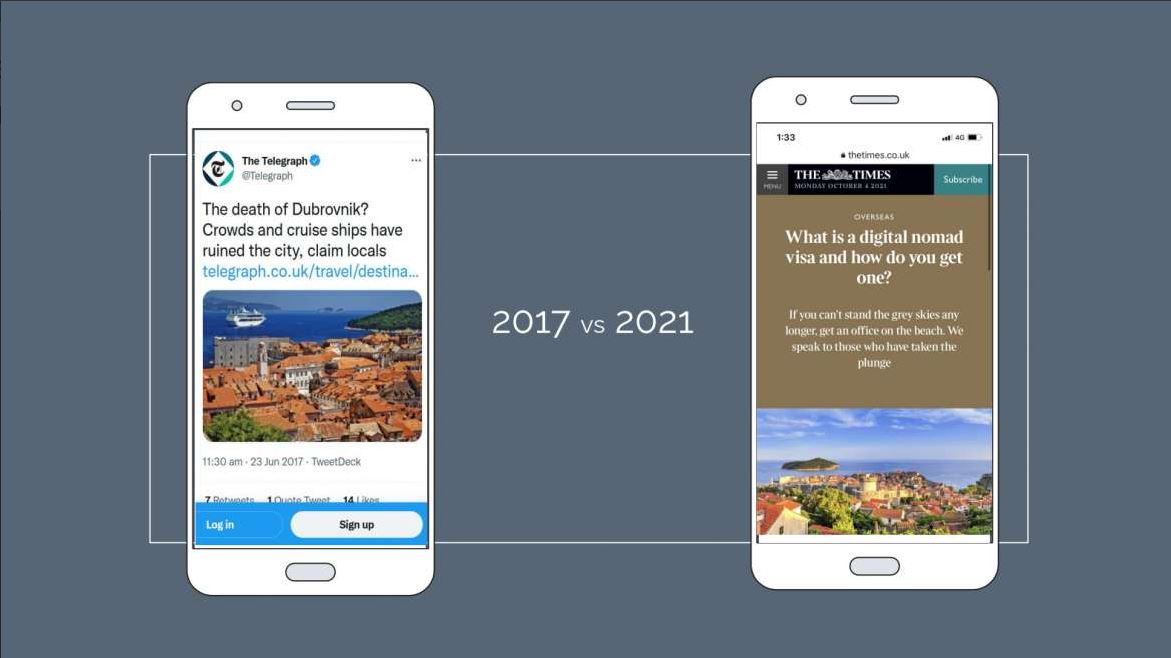Dubrovnik Announces 'Work. Place. Culture.' Remote Work Conference in May
March 14, 2022 - The Dubrovnik digital nomad story continues, as the Work. Place. Culture. Conference is announced, bringing work from anywhere to absolutely everywhere.
Good things are happening in the Pearl of the Adriatic.
A new initiative to reposition the iconic Croatian city, known also to millions as Kings Landing, is already paying handsome dividends.
A media poster child for overtourism back in 2017, Dubrovnik is now attracting headlines for very different reasons. Dubrovnik's decision to explore the remote work path has propelled itself into an increasingly popular digital nomad destination. In partnership with Saltwater Nomads and Total Croatia News, the City of Dubrovnik and Dubrovnik Tourist Board hosted Croatia's first-ever digital nomad conference back in October 2020, Dubrovnik for Digital Nomads, a conference which achieved considerable global attention, including a mention in the Washington Post.

This was followed in April 2021 with the Dubrovnik Digital Nomads in Residence programme, the first of its kind in the world, in which the destination and its community co-created a future strategy for digital nomad tourism, in partnership with 10 resident nomads who contributed their expertise as guests of the city for 4 weeks. Read more in Dubrovnik Digital Nomads-in-Residence: Meet the Creators, Download Case Study.
DNIR has already won two international awards, as well as considerable global acclaim, and Dubrovnik is continuing its innovative path in the sector with the announcement of a major conference from May 5-7, 2022 - Work. Place. Culture. From the official conference website:
Welcome – to the conference which brings work from anywhere to absolutely everywhere. Join remote professionals and destinations from around the world as they inspire a global workforce who have greater location flexibility than ever before, and the destinations which are reinventing to support them through policy, infrastructure and community.
Work. Place. Culture. is designed for destinations, companies and service providers in the remote work space:
Destinations
- looking to attract remote workers and digital nomads.
- connect and collaborate with regions and “nomad trails”
- share success stories and further build your profile to a global audience in an event blending destinations + decision-makers.
Companies
- creating/updating remote/hybrid work policy, looking for expertise and global best practice for talent attraction, retention, productivity and wellbeing.
- with a remote work policy – promote your business to attract global talent and build profile as leading RW companies.employees:
- learn about advocacy and support for remote work, travel and work from home (wfh).
Service Providers
- Tools: remote collaboration, hiring, consulting, legal & tax
- Teams:off-sites, team building, wellbeing, coaching, etc.
- Digital Nomads: vanlife, retreats, communities, sustainability.

Set against the backdrop of gorgeous Dubrovnik in early season, the conference will additionally offer fantastic experiences such as NetWALLking along Dubrovnik's historic UNESCO walls, sea kayaking, and plenty of treats for Game of Thrones lovers. Tickets include conference day lunch and dinners. Early Bird tickets are available until April 4 and can be booked via the official website.
A full list of speakers will be announced shortly, and they will include 3 of the top 10 remote work voices on LinkedIn, who will all be coming in person. You can download the programme here.

It promises to be an information-packed event, set in delightful Dubrovnik, and an outstanding networking opportunity for destinations, companies and service providers. But there is more...
We will shortly be launching the first official workation pilot by the Dubrovnik Tourist Board, with Win a Workation launching on 15 March, for a team of four to enjoy a 5-star experience at Sun Gardens and present at the conference.
And for those of you planning to attend this conference, there are many reasons why you should stay a little longer in Croatia. Nomadbase will be having their conference in Primosten from May 9-15, and the award-winning Zagreb Digital Nomad Week returns in June to the Croatian capital - more details will be released on both the Win a Workation and Zagreb Digital Nomad Week later this week.
Work. Place. Culture. is a collaboration between the City of Dubrovnik, Dubrovnik Tourist Board, Saltwater Nomads and TCN, with support from the Digital Nomad Association Croatia and Dubrovacka Bastina. Zagreb Digital Nomad Week is a partnership between Zagreb Tourist Board, Saltwater Nomads, and TCN.
To learn more about magnificent Dubrovnik, check out the Total Croatia Dubrovnik in a Page guide, in partnership with Sun Gardens Dubrovnik.
For more news and features on digital nomads in Croatia, follow the dedicated TCN section.
Croatian Fuel Prices Expected to Leap Once Again Tomorrow
March the 14th, 2022 - With inflation continuing on its global upward trajectory and with the Croatian Government set to put its inflation-curbing measures into place only on the 1st of April, Croatian fuel prices will likely shoot up once again tomorrow.
As Poslovni Dnevnik writes, yet another very unwelcome new increase in Croatian fuel prices is expected from Tuesday the 15th of March. As it turns out, that fuel price leap will stand at about one kuna and 60 lipa, meaning that a litre of petrol would rise to 13 kuna and 79 lipa, and diesel to 14 kuna and 13 lipa per litre. Some Croatian economists are reassuring people that oil will not become so expensive for a long time yet, as reported by Dnevnik.hr.
"This rise in Croatian fuel prices is likely to come to a halt later on this year, regardless of the outcome of the political and military situation unfolding over in Ukraine, meaning that market mechanisms will begin to work, namely at high prices, and consumers will begin to reduce their consumption," said well known Croatian economic analyst Damir Novonty.
Bus transport companies, which have faced hardship after hardship as a result of the coronavirus pandemic and its accompanying restrictions, as well as a lack of state intervention, will no longer be able to function normally without the help of the government.
The above was recently warned about from the Association of Public Line Carriers, especially in rural areas of the country where buses are the only means of transport for locals to get to school, work, pharmacies or to the shops. You can read more about that here.
Until then, Croatian transport companies, primarily bus carriers, the association says, will be forced to raise their ticket prices by 30 percent if government aid continues to lack as we move forward. An example of that would be that a typical Zagreb-Split bus ticket would increase in price by about fifty kuna.
For more, make sure to check out our lifestyle section.
Croatian Tech Companies Have Chance at EIB Cash Earmarked for Dual Research
March the 14th, 2022 - Croatian tech companies now have a chance at getting their hands on a slice of the ''cake'' being offered by the European Investment Bank (EIB) following the launch of a Strategic European Security Initiative (SESI) worth up to 6.6 billion euros by the year 2027.
As Poslovni Dnevnik/Ana Blaskovic writes, with the war continuing to rage in Eastern Europe following the Russian invasion, both EU and non-EU European countries are turning to stronger investment in defense and security.
The aforementioned money is earmarked for dual research (for civilian and military use), development and innovation, civilian security infrastructure and state-of-the-art technology projects, from space investment, AI, quantum technology, cyber and bio security including human security, food production and resources like water.
This new initiative will not change the definitions of excluded sectors, which specifically means that the EIB will not continue to finance armaments and defense as it is fundamentally defined. "SESI projects must be dual-purpose and guided by civilian implementation, which means that they're expected to have predominantly civilian use," the bank said.
A chance for the Croatian academic community as well
Gordan Pesic, who is in charge of business development at DOK-ING, has welcomed the EIB's initiative, believing that there are many opportunities within it for Croatian tech companies, but also for the academic community.
"There's certainly room in that programme for Croatian manufacturers, especially for those who close the so-called ''capability gaps'' in terms of security. Among them is DOK-ING, which produces robotic and automated high value-added systems that move people out of imminent danger,'' said Pesic.
Although it doesn't fund arms manufacturers or basic defense, the SESI initiative's propositions leave ample room for maneuver. "Croatian tech companies like the Osijek startup Orqa, Sestan Busch, GDI, and even textile companies developing smart materials could fit into that framework," he said.
DOK ING, at the recently concluded World Defense Show in Saudi Arabia (and about which we recently wrote), attracted a lot of attention from the Saudis with its Chest of Drawers, a unique robotic platform for operating in conditions of chemical, biological, radiological and nuclear hazards.
In addition to the real space sector, according to Pesic, there is also room for research projects taking place in institutions such as the Faculty of Electrical Engineering and Computing and the Faculty of Mechanical Engineering and Naval Architecture, as well as a range of sophisticated computer solutions, such as AI.
The Croatian tech company Orqa, which is now a world-famous startup for highly innovative drone management goggles, has also confirmed its potential interest in this new European funding programme.
"A lot of things we're developing naturally are dual purpose things, from radio communication solutions to remote vision systems, and drone technology in general," explained co-founder and CEO Srdjan Kovacevic, noting that they have used both European and Croatian funding sources effectively in the past.
''We're developing a system for transmitting video signals with low latency, which means that the video signal has a small delay and enables the efficient and precise control of a remote platform (such as a boat, vehicle or drone), it's for hobby drones, but essentially the same technology can be used defensive purposes,'' he explained.
Referring to the current turn of Europe and the EU as a bloc towards strengthening defense and security, Kovacevic says that Europe, unlike the United States, has invested very little in these segments through initiatives of private innovative companies, so in light of current events it is not surprising that there are now attempts being made to try to reduce the gap.
For more on Croatian tech companies, check out our business section.
Zagreb's ZET to Introduce New Timetable as Changes Take Place
March the 14th, 2022 - Some changes are coming to Zagreb's ZET public transport system owing to global logistics chains and there will be some alterations in the timetable as a result.
As Poslovni Dnevnik writes, as of today (Monday the 14th of March) ZET will be introducing a new timetable for the capital city's means of public transport that will reduce the number of departures on most tram lines and thirteen bus lines.
To be more precise, all of the current tram lines except 1, 5, 8 and 15 will be running less often. Line 4 will, for example, instead of every 7-8 minutes from the turnoff, leave every 8-9 minutes, meaning that in one hour there will be five to six departures instead six to seven.
This new ZET timetable, they say, is being introduced due to "global circumstances affecting supply and logistics chains". You can see the new timetable by clicking here.
A new schedule for ZET departures will also be applied in bus traffic, but only on lines 109 (Crmomerec - Dugave), 115 (Ljubljanica - Spansko - Jankomir), 118 Trg Mazuranica - Voltino), 121 (Crnomerec - Karaznik - Gajnice), 125 (Crnomerec - Gornje Vrapce), 172 Zagreb (Crnomerec) - Zapresic, 212 (Dubec - Sesvete), 224 (Dubec - Novoselec), 226 (Kaptol - Remete - Svetice), 231 (Borongaj - Dubec), 232 (Dubrava - Cret) ), 269 (Borongaj - Sesvetski Kraljevec) and 281 (Central Station - Novi Jelkovec) as was reported from ZET.
For more, make sure to check out our dedicated lifestyle section.
Seeing as you're already reading about tram and bus lines in the Croatian capital, why not have a look at just where they can take you? Check out Zagreb in a Page.
KLM Flights to Split and Dubrovnik Resume March 27, 2 Daily Flights to Zagreb Continue
March 14, 2022 - The latest flight news to Croatia as KLM flights to Split and Dubrovnik resume from March 27, and two daily flights to Zagreb Airport continue.
Dutch national airline KLM Dutch Airlines reintroduces regular seasonal lines to Split and Dubrovnik with the start of the summer flight schedule, which comes into force at the end of this month, reports Croatian Aviation.
While KLM will re-introduce regular flights from Amsterdam to Split and Dubrovnik from Sunday, March 27, the Dutch airline continues to operate twice a day to Zagreb Airport.
The first flight to Split Airport in this year's summer flight schedule has been announced for Sunday, March 27. Initially, two flights a week have been announced, every Saturday and Sunday. Before the Easter holiday, the airline is planning a number of operations, and from the end of April, KLM should operate daily between Split and Amsterdam. In the peak summer season, up to three daily flights between Amsterdam and Split of this airline are expected.
KLM will also resume traffic to Dubrovnik on the first day of the summer flight schedule, on the Amsterdam line that was reintroduced last season. Two flights a week have been announced, also on Saturdays and Sundays, and there should be an increase in weekly operations at the end of April. As was announced earlier, KLM should work up to twice a day between Dubrovnik and Amsterdam this summer.
Despite the increase in the number of operations to coastal airports last year and this year, KLM plans to continue with two daily flights to Zagreb but using mainly the Embraer fleet, which has a significantly lower capacity compared to Boeing. The Embraer and B737-700 fleets are planned on the lines to Croatia in March and April.
For more on flights to Croatia and other travel announcements, make sure to check out our dedicated travel section.
Petra Martić Knocks Out US Open Winner for Indian Wells Masters Round of 16
March 14, 2022 - Petra Martić advanced to the round of 16 of the Indian Wells Masters, defeating the current winner of the US Open, 18-year-old British Emma Raducanu (WTA - 13th) in the 3rd round with 6-7 (3), 6-4, 7 -5 after two hours and 46 minutes of play.
Martić thus reached the round of 16 in Indian Wells for the second time in her career. The first time she managed to do so was in 2018 when she made it to the quarterfinal when the world's best tennis player Romanian Simona Halep topped her in three sets.
For a spot in the quarterfinal, the 31-year-old will play against the Russian Ludmilla Samsonova, who defeated Montenegrin Danka Kovinić 6-4, 7-6 (4) in the 3rd round. Their history of joint meetings is on the side of the Croatian tennis player who has celebrated in all three of their previous matches, but Samsonova has advanced in the meantime and reached 32nd in the WTA rankings.
Unlike Samsonova, Martić dropped to 79th place and only managed to win three in Indian Wells, which happened to her for the first time since last year's WTA 1000 tournament in Rome.
Martić took a 3-1 lead against Raducanu in the first set and lost four games in a row. With a new break, she managed to extend the set to 4-5 and take it to a tie-break. After that, however, the British tennis player was more precise, and after an hour of play, she reached the initial advantage.
Raducanu took a 2-1 lead with a break in the second set. Martić scored three games and lost the serve again. However, with a 5-4 lead, Petra managed to win the third set with a new break.
She opened it with a 2-0 lead but immediately allowed her opponent to come back. Raducanu took a step towards victory when in the ninth game, she took the service away from Martić for the sixth time in the match. But she did not reach the match point. Instead, Martić used the third opportunity to break in the tenth game and then profited from a series of mistakes that the 18-year-old Briton made in the last two games in which she won only two points.
The final statistics showed more errors by Martić (51-41) and more direct points (36-28). However, the decisive factor was that at no time, regardless of the result, did Petra lose her concentration and faith and eventually turned the match around in her favor.
Marin Čilić failed to make it to the third round of Indian Wells. The best Croatian tennis player (24th place) was stopped by Serbian Miomir Kecmanović, the 61st tennis player in the world, after a dramatic finale - 6-7 (7), 6-3, 7-6 (6).
In the decisive tie-break, Marin missed two match points (6-4) and did not reach the point by the end of the match.
He scored a total of 13 aces with a modest first-serve percentage of 48 percent and used just one of 13 break points in the match.
Source: HRT
To read more about sport in Croatia, follow TCN’s dedicated page.
HNL Round 27 Recap: Hajduk-Dinamo Ends 0:0, Last-Placed Dragovoljac Tops Rijeka
March 14, 2022 - The 27th round of the Croatian First League was held from March 11 to 13, 2022. This round featured the highly anticipated 'Eternal Derby' between Hajduk and Dinamo, while Osijek and Rijeka both complicated their fight for the title. Here is our HNL round 27 recap.
Šibenik v. Lokomotiva (1:4)
Sibenik and Lokomotiva opened the 27th round on Friday, March 11, 2022, in Sibenik in front of 405 fans.
Grezda put Sibenik in the lead with a goal in the 14th minute for 1:0. Kacavenda equalized for 1:1 in the 65th minute before Soldo put Lokomotiva in the lead two minutes later. Sibenik's Peric received his second yellow less than 5 minutes later, forcing Sibenik to play with a man down for the remainder of the match. Kacavenda scored again to make it 1:3 in the 76th minute and Tuci scored for 1:4 to confirm the Lokomotiva victory.
Sibenik is currently in 8th place with 26 points while Lokomotiva is in 5th with 36.
Slaven Belupo v. Istra 1961 (0:0)
Slaven Belupo and Istra met in Koprivnica on Saturday, March 12, 2022.
Neither team was able to score and the match ended 0:0. Belupo had 17 total shots to Istra's 7, of which only 4 were on target (Istra had only 2). Belupo received 5 yellow cards to Istra's 4.
Belupo is currently in 7th place with 30 points, while Istra is in 9th with 24.
Hajduk v. Dinamo (0:0)
Hajduk and Dinamo met for the highly anticipated 'Eternal Derby' at Poljud on Saturday, March 12.
While the atmosphere was better than ever at the sold-out Poljud, for the first time full thanks solely to Hajduk's members and season ticket holders, the derby itself was one of the less exciting meetings between the two rivals. The match went without goals, though Hajdkuk had 3 shots on target to Dinamo's 0. Hajduk had slightly less possession than Dinamo (44%/56%).
Hajduk is currently in 4th place with 49 points and a game in hand, while Dinamo is in 1st with 54 points and a game in hand. These two teams play last season's makeup match on April 20 at Poljud.
Dragovoljac v. Rijeka (2:1)
Dragovoljac and Rijeka met in Zagreb on Sunday, March 13, 2022.
Certainly the most shocking match of this round, Dragovoljac took the lead in the 23rd minute thanks to Peric (1:0). Peric opened the second half with another goal for 2:0 in the 50th minute. Ampem gave Rijeka some hope in the 74th minute scoring for 2:1, while VAR recalled a Dragovoljac goal in the 83rd minute for being offside.
Dragovoljac is currently in the last place with 13 points, while Rijeka is in 3rd with 52.
Osijek v. Gorica (0:0)
Osijek and Gorica closed out the 27th round on March 13, 2022, at City Garden Stadium.
Yet another match of the 27th round that went without goals, Osijek had only 51% possession to Gorica's 49%. Osijek also had only 3 shots on target to Gorica's 6!
Osijek is currently in 2nd place with 54 points, while Gorica is in 6th place with 33 points.
You can see the HNL standings HERE.
To read more about sport in Croatia, follow TCN’s dedicated page.
Women's Football in Croatia: Origins and Status Today
14 March 2022 - Women’s football in Croatia has gone through many changes throughout its history - from being solely a man’s sport to becoming one of the most popular for women worldwide. However, in Croatia, women's football still hasn’t received the traction it has in other countries, and many clubs, especially in Eastern Slavonia, saw an inevitable end. Why has this been happening, and what are the solutions to bring back the lost talents in women’s football? A look into women’s football in Croatia.
Women’s football has had many ups and downs throughout history. From being dismissed as only a man’s sport to its “golden age,” the ban that stopped the sport's progress and, in the end, one of the most significant rises in popularity of any sport in history. The “golden age” occurred in England at the beginning of the 20th century when British men were deployed and sent to the frontline during WWI. According to a BBC Three article from 2016, by 1921, there were around 150 women’s teams in England. A Boxing Day match in 1920 drew in crowds of nearly 70,000. However, after the war ended, women were pushed back to their “places” - closed in the houses to be housewives. In 1921, the “ban” was established, declaring it to be “quite unsuitable for females and ought to be encouraged!”. This “rule” was not lifted until 1971, and unfortunately, the damage has already been done.
If we compare Croatian women’s football history from that timeline, we could say it’s been a bit different. However, even though that sort of ban hasn’t occurred in the established Kingdom of Serbs, Croats, and Slovenes and later the so-called Kingdom of Yugoslavia, reservations about women in football were emphasized a lot. According to Grgic and his article “A Brief History of Women’s Football in Croatia/Yugoslavia in Between War Period,” football was generally open to both sexes. However, “experts” pointed out that women as sentient beings do not need to seriously follow men in sports because those who do it turn into masculine people. Throughout the article, Grgic also mentions multiple instances where football was solely considered for men, and women can only use it as a prop to “get into shape and take it easy because women are fragile.” This puts a lot of factors in perspective if we consider that communist countries (especially after WWII) like Yugoslavia set a significant emphasis on women's rights and their “rightful” part of the “revolution.” Still, even that couldn’t stop discrimination against women. But, once again, that didn’t stop women from playing football. For instance, ŽNK Dinamo-Maksimir is a Croatian women's football club based in Zagreb, and the club was founded as ŽNK Maksimir in 1937. The Yugoslav First Women's League was active between 1974 to 1991 and the fall of Yugoslavia. Zagreb, later called Maksimir, was the only Croatian club in the League, and the club with the most titles was Mašinac from Niš.
After the Homeland War, many Croatian women’s football clubs were founded, which led to the eventual establishment of the Croatian Women's First Football League formed in 1992, following the dissolution of the Yugoslav First Women's League, which is currently underway and features eight clubs.
However, in recent decades, women’s club popularity has not helped the sport's popularity in Croatia, especially in regions like Eastern Croatia. Yes, ŽNK Osijek is the most successful Croatian club in the country, but it didn’t help the inevitable shut down of multiple women’s football clubs, especially in Vukovar - Srijem county.
For instance, out of ten active women’s football clubs in the last two decades, only five of them stayed active with ŽNK Mikanovci, NK Dilj Vinkovci, and Graničar Županja mainly operating in Croatian Women’s Second League. The rest of them work only in younger categories. Displacement of the population, lack of children, and girls' disinterest in the sport made clubs shut down. Girls who wanted to play football had to go to other towns and clubs that were still active, and the best would go to ŽNK Osijek.
Also, most Croatian women’s football clubs pay miserable salaries to their players who are just too low for today’s living standards, whereas in lower league clubs' wages are just non-existent. However, in recent years there has been progress, namely in the infrastructure of the Leagues and clubs, possibilities of the clubs to pay to their players, and constant promotion of women’s football games. It made everything so much easier because of social media and an overall rise in the sport's popularity internationally.

Out of ten clubs, five of them shut down in recent years, and the rest of them are mainly operating in younger categories - Screenshot: Wikipedia
*ugašen (shutdown) *djeluje u mlađim kategorijama (operating only in younger categories)
After the ban was lifted in the UK, women’s football finally progressed. Leagues and football clubs were founded, and the first World Cup in 1991 in China was finally held. In recent times, FIFA World Cup in 2015 and 2019 reached new heights in popularity and brought unprecedented ratings, which could be compared to Olympic Games. Women’s football is now a rapidly growing sport that finally started getting an influx of money and popularity long ago.
Croatian FA recently joined the UEFA Playmakers program, which was created with Disney. The project's primary goal is to introduce football to girls aged 5 to 8 who never experienced playing sports. The program will take place in 2022 and 2023, and four editions will be organized. The first edition - in March 2022 - will follow the animated film Frozen 2. The training will take place on the fields and/or in the halls of women's football clubs so that girls can join the clubs and continue playing football after participating in the UEFA Playmakers program. This project will also include cities all over Croatia and help promote the sport to girls across the country.
In conclusion, after everything researched, we can say that the rise of women’s football in Croatia is inevitable. Of course, it will take a long time since nothing can be done in one day, but positive times are here. Croatian Women’s Football Leagues are slowly but surely developing talent. The Croatian National Team is playing in playoffs for multiple big tournaments, and I don’t doubt that they will one day qualify. The interest in the game is rising again - even though many clubs shut down, girls are once again willing to play football, and rightfully so, because it’s our game too - a women’s game.
To read more about sport in Croatia, follow TCN’s dedicated page.
11th Book Night to Take Place From 22-25 April
ZAGREB, 13 March 2022 - The 11th edition of Book Night, the national event promoting reading and books, will take place on 22-25 April, coinciding with World Book and Copyright Day (23 April) and Croatian Book Day (22 April), the organisers announced earlier this week.
The focus of this year's event will be on "books as a space of freedom".
This year marks two important anniversaries - the 400th anniversary of the birth of French playwright Molière, who found his space of freedom in farce and comedy, using them as a vehicle for a critique of the society of his time, and the 100th anniversary of he birth of Croatian poet Vesna Parun.
The organisers expect over a thousand programmes by libraries, bookshops, publishers, educational institutions, museums, local government authorities and other institutions and organisations. Admission to many of the events will be free.
For more, check out our lifestyle section.
Croatia Reports 956 New Coronavirus Cases, 15 Deaths
ZAGREB, 13 March 2022 - Croatia has recorded 956 new coronavirus cases and 15 COVID-related deaths in the last 24 hours, the national coronavirus response team reported on Sunday.
The number of active cases currently stands at 9,830. Among them are 764 infected people who have been hospitalised with 49 of them are on ventilators. 7,198 people are self-isolating.
A total of 4,583,892 people have been tested for the SARS-CoV-2 virus to date, including 4,356 in the last 24 hours.
Since 25 February 2020, when the first case was confirmed in Croatia, 1,073,386 people have been registered as having been infected with the novel virus, of whom 15,336 have died and 1,048,220 have recovered, including 1,226 in the last 24 hours.
By Saturday, 5,209,274 COVID vaccine doses have been administered, with 56.89% of the total population, or 67.66% of adults, having been vaccinated.
A total of 2,308,528 people have received at least one dose and 2,234,390 of them have been fully vaccinated, or 65.61% of the adult population.
For all you need to know about coronavirus specific to Croatia, make sure to bookmark our dedicated sectionand select your preferred language if it isn't English.





